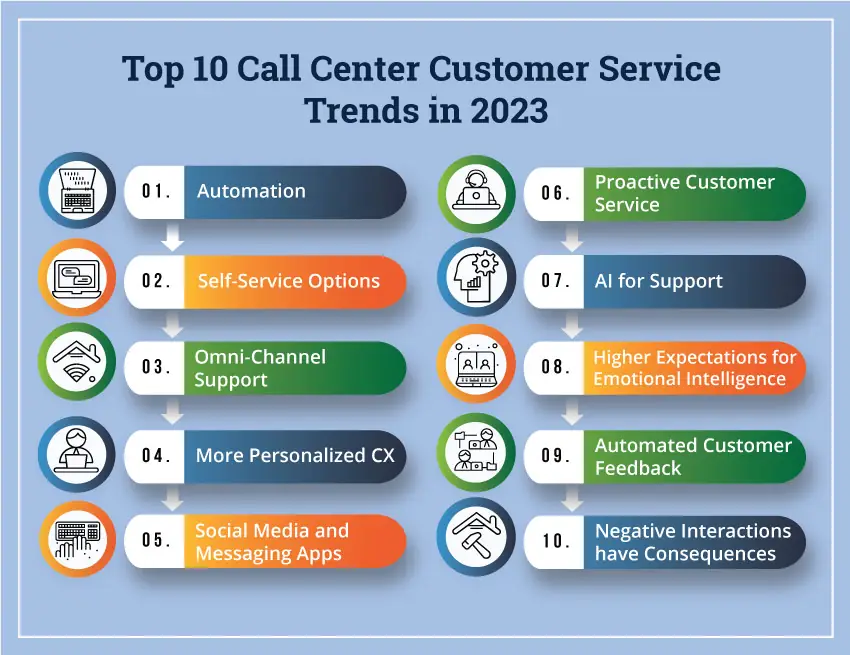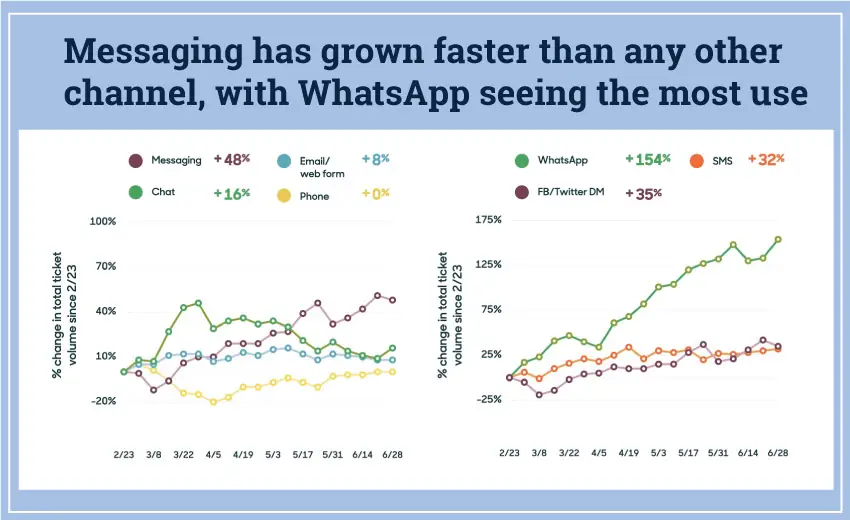It is crucial for call centers to stay up to date with trends in the industry because customer service expectations and preferences are constantly evolving. Adapting to these trends ensures that call centers can provide optimal customer service and stay ahead of their competition.
From the rise of AI-powered chatbots handling routine inquiries to the seamless integration of omnichannel support, the call center industry is experiencing a profound shift in customer service trends. We will explore how these trends redefine how businesses connect with and satisfy their customers.
However, even though there have been many technology changes in recent years, SQM Group’s customer satisfaction benchmark rating for the call center industry Csat remains unchanged in 2023. By taking advantage of new technologies such as AI and omnichannel communication, call centers have been able to provide a better CX while also reducing labor costs.
Top 10 Call Center Customer Service Trends in 2023

Of all the trends, automation is the most prominent trend in the call center industry right now. This is due to its ability to enhance operational efficiency, reduce costs, and improve customer service. By automating routine tasks, such as handling simple inquiries and data entry, call centers can free up human agents to focus on more complex interactions. This not only leads to faster response times but also reduces the risk of errors and ensures consistency in customer service.
Examples of automation in the call center industry include:
- The use of AI-driven chatbots and virtual assistants to provide instant responses to common customer queries.
- Automated call routing to ensure that calls are directed to the most suitable agents based on skills or previous interactions.
- Automation also plays a crucial role in data analytics, helping call centers gain insights into customer satisfaction, preferences, and sentiment, which can inform more personalized and effective service.
Automation is a driving force in modernizing call center operations, making them more efficient and responsive to evolving customer expectations.
Self-service in the customer service industry primarily caters to the younger generations, such as Millennials and Gen Z. These generations value speed and convenience and are more tech-savvy and comfortable using digital tools, mobile apps, and online resources to find answers and resolve issues independently.
Self-service empowers customers to find solutions to their issues on their own, reducing the need for direct agent interaction and often leading to faster problem resolution. This trend caters to the increasing demand for instant support and helps call centers manage their workloads more efficiently by diverting routine inquiries away from human agents.
Examples of self-service in the call center industry include:
- Chatbots in call centers allow customers to get assistance without speaking to a live agent.
- Interactive voice response (IVR) systems, where callers can navigate through a menu of options to find answers to common questions.
- Online knowledge bases and FAQs on company websites provide customers with a wealth of information to resolve issues independently.
- Customer portals and mobile apps enable users to check their account status, track orders, and initiate returns or cancellations independently.
By offering these self-service options, call centers can improve customer satisfaction, reduce costs, and free up agents to handle more complex and specialized inquiries.
Omni-channel support addresses the need for seamless and consistent customer interactions across various communication channels. In today's interconnected world, customers expect to engage with businesses through their channel of choice, whether it's phone calls, email, chat, social media, or in-app messaging.
Omni-channel support aims to provide a unified and cohesive experience, allowing customers to start an interaction on one channel and seamlessly transition to another without losing context. This trend acknowledges the importance of meeting customers where they are and delivering a high-quality, integrated experience that boosts customer satisfaction and loyalty.
Examples of omni-channel support in the call center industry include:
- A customer has a seamless experience across all touchpoints to resolve the same inquiry or problem. Put differently, when a customer used another touchpoint (e.g., website, IVR, chat, call center) to resolve the same inquiry or problem, they were able to pick up from where they left off in the previous touchpoint and, as a result, did not have to start from the beginning. Most omni-channel experiences are customer starting with the website and ending at the call center.
- A customer initiates a support request through social media, and the conversation seamlessly transitions to a live chat with an agent without requiring the customer to repeat information.
- It also involves integrating email, chat, and phone support into a single dashboard, where agents can access a customer's history and preferences across all channels, ensuring a personalized and consistent experience.
Overall, omni-channel support enhances the customer journey by providing a unified and responsive service experience across multiple touchpoints.
Personalized experiences respond to the increasing demand for tailored and relevant interactions. Customers no longer want to be treated as generic entities; they expect businesses to recognize their preferences, history, and needs. This approach significantly enhances customer satisfaction and loyalty, as individuals feel valued and understood.
Examples of personalized experiences in the call center industry include:
- Customer data and CRM systems provide agents with a comprehensive customer profile during interactions. This allows agents to reference previous interactions, understand purchase history, and anticipate needs.
- AI-driven algorithms can also provide personalized product or service recommendations based on a customer's past behavior and preferences.
- Personalized communication, such as addressing customers by their names and acknowledging important milestones, can go a long way in creating a more meaningful and positive customer experience.
Personalization is pivotal in building stronger, more enduring relationships between businesses and customers.
Modern consumers prefer to communicate using social media and messaging apps. These platforms offer customers an immediate and convenient touchpoint to seek support, make inquiries, or provide feedback. Customers often turn to social media and messaging apps for real-time interactions, making it essential for businesses to have a presence there.

Examples include:
- Brands provide customer support through Facebook Messenger, WhatsApp, or Twitter DMs, where agents can respond to queries and resolve issues in a conversational manner.
- The use of chatbots on websites and messaging apps to provide instant responses to frequently asked questions, offering a 24/7 support option.
This trend leverages the power of these widely used platforms to create more accessible, immediate, and customer-centric interactions.
Proactive customer service is a growing trend in the call center industry because it shifts the focus from merely reacting to customer inquiries to anticipating and addressing their needs before they even realize they have an issue.
By monitoring customer behavior and employing data analytics, call centers can identify patterns and potential problems, allowing them to reach out to customers with solutions or information, often preventing issues from escalating. Proactive service creates a positive customer experience and contributes to increased customer retention and word-of-mouth referrals.
Examples of proactive customer service include:
- Notifying customers of service disruptions or delays in real-time via SMS or email.
- After a customer interacts with the call center, proactive follow-up calls or messages can be made to ensure that the issue has been resolved to the customer's satisfaction, demonstrating a commitment to service excellence.
- Replying to a customer’s public criticism on social media humbly and apologetically.
In essence, proactive customer service uses technology and data to engage customers proactively, delivering a more convenient and tailored experience.
AI systems are becoming increasingly sophisticated, employing natural language processing to engage in more human-like conversations and effectively understand and respond to customer queries. Therefore, call centers have taken advantage of these systems for a more cost-effective and efficient solution to handle routine and repetitive customer inquiries.
Examples include:
- Chatbots on company websites or messaging apps can answer frequently asked questions, assist with account inquiries, and even guide customers through troubleshooting processes.
- AI-driven IVR (Interactive Voice Response) systems can handle straightforward phone inquiries, such as balance checks or appointment scheduling, without agent involvement, further streamlining customer support processes.
- Agent Self-Coaching. With the help of AI, SQM’s software uses post-call survey telephony and QA data to identify coaching opportunities which are displayed on the dashboard so that agents can self-coach to improve QA scores and CX.
Request a mySQM™ Customer Service QA Demo Video
Learn about SQM's agent… Csat prediction model, which is based on standardized metrics, AI, and regression analysis to predict customer satisfaction derived from a QA evaluation. Our Csat prediction model provides a high statistical correlation, translating to a 95% success rate in predicting agent Csat in most cases.
Overall, the adoption of AI for simple support requests is driven by the desire for speed, accessibility, and cost-efficiency in customer service delivery.
Customer service is no longer solely about issue resolution; it's also about building strong, empathetic, and lasting connections with customers. In today's highly competitive landscape, businesses recognize the significance of emotional engagement in customer interactions.
Examples of higher expectations for emotional intelligence in the call center industry include:
- Agents receiving specialized training in active listening, empathy, and de-escalation techniques to handle emotionally charged interactions effectively.
- Call centers may also implement sentiment analysis tools to gauge customer emotions during interactions, providing agents with real-time insights to tailor their responses accordingly.
This trend reflects the understanding that customers value efficient issue resolution and compassionate and emotionally intelligent interactions with call center representatives.
This trend streamlines the process of gathering and analyzing customer opinions, providing valuable insights to enhance service quality and overall customer satisfaction. Call centers can capture a more comprehensive view of customer experiences by automating feedback collection.
Examples of automated customer feedback in the call center industry include:
- Post-interaction surveys delivered via conversational IVR survey, email, or SMS, asking customers to rate their experience and provide comments.
- Real-time analytics can alert call center supervisors to negative feedback or customer dissatisfaction, allowing them to take immediate action to resolve issues and prevent further escalations.
This trend reflects the growing importance of data-driven decision-making in the call center industry, enabling continuous improvement and enhancing the customer experience.
Due to the increased power of social media and online reviews, negative customer interactions now carry higher consequences. In today's digital age, dissatisfied customers can quickly share their negative experiences with a vast audience, potentially causing reputational damage to a business.
If not resolved effectively and promptly, negative interactions can lead to viral social media posts, negative reviews on platforms like Yelp and Google, and public criticism that can impact a company's brand and revenue. Moreover, with the abundance of alternatives available to consumers, a single negative interaction can prompt customers to switch to a competitor, making customer retention more challenging than ever.
- Negative customer service interactions can quickly go viral on social media, causing more significant reputational damage than in the past when issues were mostly limited to word-of-mouth.
- Online reviews and ratings affect a company's online reputation and influence potential customers, a consequence that was less pronounced in the past.










